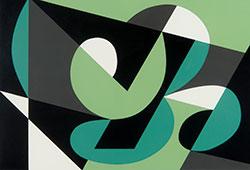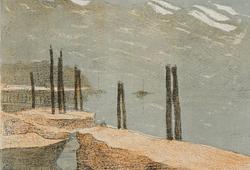Albert Edelfelt
"A GIRL FROM PORVOO (A FARMER'S DAUGHTER FROM UUSIMAA)".
Sign. Oil on canvas 37,5x36 cm.
Exhibitions
Retretti Art Center, Punkaharju 1983.
Literature
Hintze no 742.
More information
Executed 1895.
Albert Edelfelt 1854-1905
BORGÅ GIRL (PEASANT GIRL FROM UUSIMAA). Sign. Oil on canvas 37,5x35,5 cm. Painted at Haiko in 1895.
Literature: B. Hintze, Albert Edelfelt, 1942-44, catalogue no. 742.
Exhibitions: Exhibition of Finnish artists 1895; Memorial exhibition 1910, no. 136;
Finnish Art in Swedish Museums and Collections, Malmö museum 1967 no. 55a; Retretti
1983, no.137.
"The palette, after all, is poor, and one need never be afraid of producing colours more bright or vivid than the ones painted by the sun".
Albert Edelfelt, 1890
”Borgå Girl” is a brilliant example of Edelfelt's use of the clear palette. The model is thought to be Tilda Klang, a local crofter's daughter and one of Edelfelt's favourite models. Described as having unusually large, glittering blue eyes, she is here depicted simply as a smiling young girl from Borgå out enjoying the beautiful birch forest. Later, after the death of the artist, the work was renamed ”Peasant Girl from Uusimaa”. The new name originates in Gunnar Berndtsson's work: in 1887 Berndtsson completed a work depicting a girl in a forest, reading a book – an Uusimaa peasant girl. The work was part of a series of illustrations for the book ”Hemma – Skildringar från Östra Nyland” (approx. ”Home – Depictions of East Uusimaa”) which focuses on life at the estates of the region. Edelfelt's interpretation of Berndtsson's work, however, draws mainly on the themes and palettes of the Glasgow Boys, at the time considered avant-garde by the Scottish and English art academies and whose style Edelfelt greatly admired. This admiration is visible as a shift in the atmosphere of his works, moving from the overcast and silver-edged to peinture claire, as Edelfelt, having never truly embraced the darkness and the contour drawings of symbolism, was especially inspired by the 1890s tendency of the Glasgow Boys to paint primarily with clear, bright colours.The Glasgow Boys, in turn, were inspired by the naturalism of Jules Bastien-Lepage and tonal harmonies of James McNeil Whistler.
(MC)
Designer
Albert Edelfelt is considered one of Finland's greatest artists of the 19th century. After studying in Antwerp and Paris, he settled in France, where he received several exhibition medals and was honored with the Legion of Honour, notably for the famous portrait of Pasteur. He was also summoned by Alexander III to St. Petersburg to portray the Tsar's children. Edelfelt often returned to themes from Finnish history, such as his illustrations for 'The Tales of Ensign Stål.'
Edelfelt's works display an artistic breadth that ranges from everyday life in the Finnish archipelago to prestigious society portraits and historical paintings. In his depictions of everyday life, he managed to merge traditional academic painting with the new techniques of plein air painting, which achieved great success in France. The painting 'The Funeral of a Child' was awarded a third-class medal at the annual Salon in Paris in 1880, marking the most significant international success for Finnish painting at the time.
Albert Edelfelt is primarily represented in Ateneum in Helsinki, but also in the National Museum in Stockholm, as well as museums in Copenhagen, Luxembourg, and Paris.
Read more





































